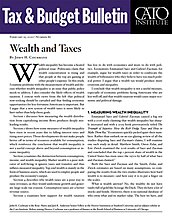1. The 2016 study was Emmanuel Saez and Gabriel Zucman, “Wealth Inequality in the United States since 1913: Evidence from Capitalized Income Tax Data,” The Quarterly Journal of Economics 131, no. 2 (May 2016): 519–578.
2. Matthew Smith, Owen Zidar, and Eric Zwick, “Top Wealth in the United States: New Estimates and Implications for Taxing the Rich,” working paper, July 19, 2019.
3. Smith, Zidar, and Zwick, “Top Wealth in the United States,” p. 3.
4. Smith, Zidar, and Zwick, p. 11.
5. The wealthy have higher yielding but riskier assets, such as junk bonds, while less rich people have lower yielding but safer assets such as bank accounts. Note that various regulations prohibit people with lower incomes from buying the kinds of assets that make rich people richer in the name of consumer protection.
6. Smith, Zidar, and Zwick, “Top Wealth in the United States,” p. 4.
7. Smith, Zidar, and Zwick, p. 11.
8. Smith, Zidar, and Zwick, pp. 19–20.
9. Smith, Zidar, and Zwick, p. 42.
10. Note to economists: Yes, it is true that lower real interest rates generate a substitution effect. You should rearrange consumption to be earlier rather than later. But the central point is that the lower interest rate does not allow you to consume more in every year than you could before. Wealth arising from higher earnings does. This is a rather deep point that gets lost all too often in the static Keynesian consumption function thinking about “wealth effects of consumption” that still pervades macroeconomics. “Wealth” that comes from a decline in discount rate should not have much of an effect on consumption.
11. Saez and Zucman, “Wealth Inequality in the United States since 1913,” p. 521.
12. Saez and Zucman, pp. 525–526.
13. Smith, Zidar, and Zwick, “Top Wealth in the United States,” p. 8.
14. Phil Gramm and John F. Early, “The Truth about Income Inequality,” Wall Street Journal, November 3, 2019. See also John F. Early, “Reassessing the Facts about Inequality, Poverty, and Redistribution,” Cato Institute Policy Analysis no. 839, April 24, 2018.
15. Gramm and Early, “The Truth about Income Inequality.”
16. Gerald Auten and David Splinter, “Income Inequality in the United States: Using Tax Data to Measure Long-term Trends,” working paper, December 20, 2019, http://davidsplinter.com/AutenSplinter-Tax_Data_and_Inequality.pdf.
17. See John Cochrane, “Who Pays More Taxes,” The Grumpy Economist (blog), October 18, 2019.
18. Hank Adler and Madison Spach, “How to Pay the Wealth Tax: Sell Everything,” Wall Street Journal, December 12, 2019.
19. Adler and Spach, “How to Pay the Wealth Tax.”
20. Emmanuel Saez and Gabriel Zucman, “How Would a Progressive Wealth Tax Work? Evidence from the Economics Literature,” working paper, February 5, 2019, p. 5.
21. Saez and Zucman, “How Would a Progressive Wealth Tax Work?,” p. 19.
22. Saez and Zucman, p. 19.
23. Saez and Zucman, p. 20.
24. Saez and Zucman, footnote 27.
25. Paul Sullivan, “Raise Billions from Billionaires? Tax Experts Say It’s Not That Simple,” New York Times, November 15, 2019.
26. See John Cochrane, “A Progressive VAT,” The Grumpy Economist (blog), April 26, 2017.
27. Emmanuel Saez and Gabriel Zucman, “Alexandria Ocasio-Cortez’s Tax Hike Idea Is Not about Soaking the Rich,” New York Times, January 22, 2019.
28. Saez and Zucman, “Alexandria Ocasio-Cortez’s Tax Hike Idea.”
29. John Cassidy, “Why Elizabeth Warren’s Wealth Tax Would Work,” New Yorker, January 31, 2019.
30. See Ryan Bourne, “Has Wealth Inequality Eroded U.S. Democracy?” Cato at Liberty (blog), October 24, 2019, for numbers showing the political preferences of the very rich.
31. Chris Edwards and Ryan Bourne, “Exploring Wealth Inequality,” Cato Institute Policy Analysis no. 881, November 5, 2019.
32. George Bernard Shaw to Edward Rose, September 25, 1899, in Bernard Shaw: Collected Letters, 1898–1910, vol. 2, ed. Dan H. Laurence (Viking, 1985).
33. Saez and Zucman, “Alexandria Ocasio-Cortez’s Tax Hike Idea.”
34. Robert Reich, “Under Real Capitalism, Billionaires Shouldn’t Exist,” Newsweek, November 11, 2019.
35. Edwards and Bourne, “Exploring Wealth Inequality.”
36. Edwards and Bourne.
37. Emmanuel Saez, “Income and Wealth Inequality: Evidence and Policy Implications,” Contemporary Economic Policy 35, no. 1 (January 2017): 7–25.


